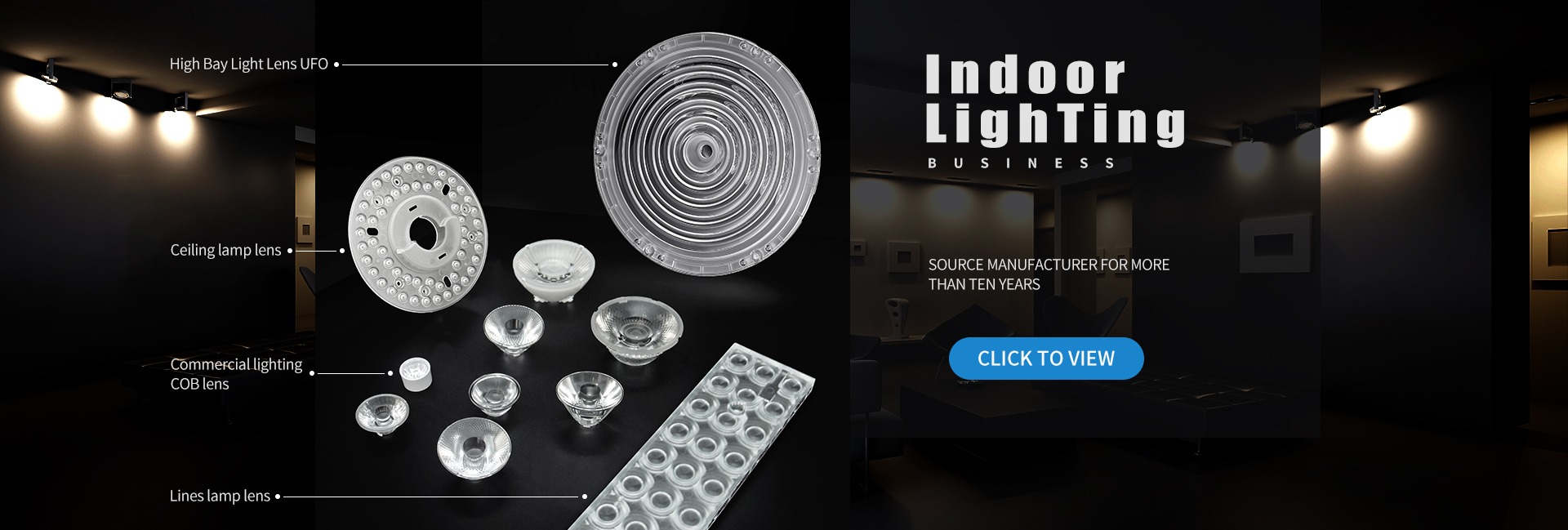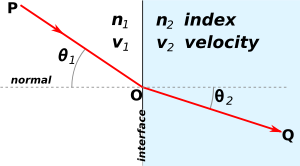


2022-12-07

Optics is the branch of physics that studies the behaviour and properties of light, including its interactions with matter and the construction of instruments that use or detect it.[1] Optics usually describes the behaviour of visible, ultraviolet, and infrared light. Light is a type of electromagnetic radiation, and other forms of electromagnetic radiation such as X-rays, microwaves, and radio waves exhibit similar properties.[1]
 Geometry of reflection and refraction of light rays
Geometry of reflection and refraction of light rays
Geometrical optics, or ray optics, describes the propagation of light in terms of "rays" which travel in straight lines, and whose paths are governed by the laws of reflection and refraction at interfaces between different media.[35] These laws were discovered empirically as far back as 984 AD[10] and have been used in the design of optical components and instruments from then until the present day. They can be summarised as follows:
When a ray of light hits the boundary between two transparent materials, it is divided into a reflected and a refracted ray.
 where n is a constant for any two materials and a given colour of light. If the first material is air or vacuum, n is the refractive index of the second material.
where n is a constant for any two materials and a given colour of light. If the first material is air or vacuum, n is the refractive index of the second material.
The laws of reflection and refraction can be derived from Fermat's principle which states that the path taken between two points by a ray of light is the path that can be traversed in the least time.[36]
 Diagram of specular reflection
Diagram of specular reflection
Reflections can be divided into two types: specular reflection and diffuse reflection. Specular reflection describes the gloss of surfaces such as mirrors, which reflect light in a simple, predictable way. This allows for the production of reflected images that can be associated with an actual (real) or extrapolated (virtual) location in space. Diffuse reflection describes non-glossy materials, such as paper or rock. The reflections from these surfaces can only be described statistically, with the exact distribution of the reflected light depending on the microscopic structure of the material. Many diffuse reflectors are described or can be approximated by Lambert's cosine law, which describes surfaces that have equal luminance when viewed from any angle. Glossy surfaces can give both specular and diffuse reflection.
In specular reflection, the direction of the reflected ray is determined by the angle the incident ray makes with the surface normal, a line perpendicular to the surface at the point where the ray hits. The incident and reflected rays and the normal lie in a single plane, and the angle between the reflected ray and the surface normal is the same as that between the incident ray and the normal.[38] This is known as the Law of Reflection.
For flat mirrors, the law of reflection implies that images of objects are upright and the same distance behind the mirror as the objects are in front of the mirror. The image size is the same as the object size. The law also implies that mirror images are parity inverted, which we perceive as a left-right inversion. Images formed from reflection in two (or any even number of) mirrors are not parity inverted. Corner reflectors produce reflected rays that travel back in the direction from which the incident rays came.[39] This is called retroreflection.
Mirrors with curved surfaces can be modelled by ray tracing and using the law of reflection at each point on the surface. For mirrors with parabolic surfaces, parallel rays incident on the mirror produce reflected rays that converge at a common focus. Other curved surfaces may also focus light, but with aberrations due to the diverging shape causing the focus to be smeared out in space. In particular, spherical mirrors exhibit spherical aberration. Curved mirrors can form images with a magnification greater than or less than one, and the magnification can be negative, indicating that the image is inverted. An upright image formed by reflection in a mirror is always virtual, while an inverted image is real and can be projected onto a screen.[40]
 Illustration of Snell's Law for the case n1 < n2, such as air/water interface
Illustration of Snell's Law for the case n1 < n2, such as air/water interface
Refraction occurs when light travels through an area of space that has a changing index of refraction; this principle allows for lenses and the focusing of light. The simplest case of refraction occurs when there is an interface between a uniform medium with index of refraction n1 and another medium with index of refraction n2. In such situations, Snell's Law describes the resulting deflection of the light ray:
�1sin�1=�2sin�2
where θ1 and θ2 are the angles between the normal (to the interface) and the incident and refracted waves, respectively.[38]
The index of refraction of a medium is related to the speed, v, of light in that medium by�=�/�,
Snell's Law can be used to predict the deflection of light rays as they pass through linear media as long as the indexes of refraction and the geometry of the media are known. For example, the propagation of light through a prism results in the light ray being deflected depending on the shape and orientation of the prism. In most materials, the index of refraction varies with the frequency of the light, known as dispersion. Taking this into account, Snell's Law can be used to predict how a prism will disperse light into a spectrum.[41] The discovery of this phenomenon when passing light through a prism is famously attributed to Isaac Newton.
Some media have an index of refraction which varies gradually with position and, therefore, light rays in the medium are curved. This effect is responsible for mirages seen on hot days: a change in index of refraction air with height causes light rays to bend, creating the appearance of specular reflections in the distance (as if on the surface of a pool of water). Optical materials with varying indexes of refraction are called gradient-index (GRIN) materials. Such materials are used to make gradient-index optics.[42]
For light rays travelling from a material with a high index of refraction to a material with a low index of refraction, Snell's law predicts that there is no θ2 when θ1 is large. In this case, no transmission occurs; all the light is reflected. This phenomenon is called total internal reflection and allows for fibre optics technology. As light travels down an optical fibre, it undergoes total internal reflection allowing for essentially no light to be lost over the length of the cable.[43]
 A ray tracing diagram for a converging lens
A ray tracing diagram for a converging lens
A device that produces converging or diverging light rays due to refraction is known as a lens. Lenses are characterized by their focal length: a converging lens has positive focal length, while a diverging lens has negative focal length. Smaller focal length indicates that the lens has a stronger converging or diverging effect. The focal length of a simple lens in air is given by the lensmaker's equation.[44]
Ray tracing can be used to show how images are formed by a lens. For a thin lens in air, the location of the image is given by the simple equation
1�1+1�2=1�,
where S1 is the distance from the object to the lens, θ2 is the distance from the lens to the image, and f is the focal length of the lens. In the sign convention used here, the object and image distances are positive if the object and image are on opposite sides of the lens.[45]

Incoming parallel rays are focused by a converging lens onto a spot one focal length from the lens, on the far side of the lens. This is called the rear focal point of the lens. Rays from an object at a finite distance are focused further from the lens than the focal distance; the closer the object is to the lens, the further the image is from the lens.
With diverging lenses, incoming parallel rays diverge after going through the lens, in such a way that they seem to have originated at a spot one focal length in front of the lens. This is the lens's front focal point. Rays from an object at a finite distance are associated with a virtual image that is closer to the lens than the focal point, and on the same side of the lens as the object. The closer the object is to the lens, the closer the virtual image is to the lens. As with mirrors, upright images produced by a single lens are virtual, while inverted images are real.[46]
Lenses suffer from aberrations that distort images. Monochromatic aberrations occur because the geometry of the lens does not perfectly direct rays from each object point to a single point on the image, while chromatic aberration occurs because the index of refraction of the lens varies with the wavelength of the light.[47]
 Images of black letters in a thin convex lens of focal length f are shown in red. Selected rays are shown for letters E, I and K in blue, green and orange, respectively. Note that E (at 2f) has an equal-size, real and inverted image; I (at f) has its image at infinity; and K (at f/2) has a double-size, virtual and upright image.
Images of black letters in a thin convex lens of focal length f are shown in red. Selected rays are shown for letters E, I and K in blue, green and orange, respectively. Note that E (at 2f) has an equal-size, real and inverted image; I (at f) has its image at infinity; and K (at f/2) has a double-size, virtual and upright image.